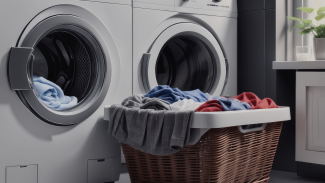Energy-saving standards for new appliances and equipment are generally required to be updated every eight years, but most are long overdue. Federal regulators are getting them back on track.
Go shopping for a new clothes dryer today and you’ll see a wide variety of models with different features. But one thing they ought to all have in common is that they don’t needlessly waste energy, thanks to federal efficiency standards ensuring they use up-to-date technology. At least, that’s how Congress intended it to work.
Yet today, many brand-new clothes dryers have outdated sensors that cause them to overdry clothes, wasting a significant amount of energy. The standards for the products haven’t been updated by the Department of Energy (DOE) since 2011, even though technology has improved. That means needless energy costs and climate pollution.
In fact, energy efficiency standards for numerous products have fallen out of date for several years. On President Biden’s inauguration day, DOE had already missed legal deadlines for proposing or finalizing updated efficiency standards for 28 different products. Deadlines for updating standards for 19 more products have since come due or will by January 2025.
The department is now on a path toward getting the standards on track. DOE conveyed its timeline publicly in a regulatory agenda in June and it must abide by a court-approved settlement agreement with similar deadlines for many of the products. It is a good plan for catching up. But there’s a lot of work ahead.
Finalizing all pending standards would reduce climate pollution by more than 2.4 billion metric tons and save consumers $570 billion from the affected products sold over 30 years, according to the department. Any delays mean more needlessly inefficient products will be sold and used for years or decades ahead, resulting in higher utility bills and more strain on the electric grid. Delays put standards at risk of being reversed or not getting the rules done during this presidential term.
Several key rules have been finalized
The first standards fully developed by the Biden administration were finalized in March, covering window air conditioners and air purifiers. The air conditioner standard will help reduce bills for low-income households, which are more likely to use these products. It will also reduce strain on the electric grid on hot days. Other completed updates will boost efficiency for commercial water heaters and for electric motors used in equipment like pumps and fans.
One of the most notable standards finalized in years came in September, when the department issued the first meaningful home furnace efficiency upgrade in more than three decades. When it takes effect in 2028, efficient models that use about 15% less energy than old-style equipment will become the norm in new furnace installations.
Many proposed standards need to be finalized
We’re now awaiting final standards for about 20 products for which DOE has proposed an updated standard and accepted public comments.
These products include many common home appliances: clothes washers, dryers, refrigerators and freezers, stoves and ovens, and dishwashers. Efficiency advocates and product manufacturers announced a consensus agreement earlier this fall and made joint recommendations for the efficiency levels and compliance dates the department should set for this group of products. We expect that DOE will issue improved standards based on these recommendations in the months ahead.
The proposed standard for electric distribution transformers has gotten a lot of attention. Because nearly all electricity flows through one or more transformers, even small amounts of energy waste by each add up to major climate pollution and higher utility bills. More-efficient transformers also make our electric grids more reliable and resilient as electricity demand grows. This summer, a group of senators urged DOE to finalize the standard and provide a compliance date later than the expected 2027 one to allow additional time for an increase in domestic production capacity of needed materials.
Another important pending standard covers residential water heaters. It would deliver the single biggest impact for households: many would save more than $200 annually if this standard is finalized. It has garnered an array of support from consumer, climate, and public health advocates, product manufacturers, local officials, and members of Congress.
A steady stream of progress
DOE is busy doing the job it was assigned by Congress. That job was updated in 2007 in a sweeping bipartisan energy bill signed by President George W. Bush. Lawmakers sought to ensure that standards would stay updated as technology advanced.
The law requires that six years after a product’s standard is established or updated, DOE must evaluate whether an improved standard would be technologically feasible and economically justified, and if so, to propose one. If not, DOE can propose to keep the standard as it is. The Biden administration has determined or proposed to determine that standards for 13 products do not merit being strengthened.
After proposing an updated standard, DOE has two years to finalize it, creating an eight-year cycle. Because the previous administration avoided setting new standards, the deadlines built up, leading to the heavier workload for DOE today. While the public would have seen a more significant benefit if standards had been updated as they came due during the previous administration, the second-best time is now.
DOE can deliver big savings for households and businesses while significantly cutting climate pollution simply by catching up on these overdue standards. The workplan ahead is clear. Now the department must get the job done.



